Copyright © 2018-2024 nothrow.com. All Rights Reserved. You may not copy and distribute the content from the Site.
Every decision, from setting your defensive line to choosing how aggressively your team engages opponents, can be the difference between a triumphant season or a forgettable one.
For both seasoned veterans and newcomers to the series, understanding the nuances of defensive tactics is crucial.
This article delves into the myriad of defensive line settings and line of engagement options available in FM24, offering insights into their strategic applications.
Key Facts about Defensive Line Positions Settings
- ✅ Defensive Line Settings Vary in Depth: From the ‘Much Lower Defensive Line’ for deep defense to the ‘Much Higher Defensive Line’ for aggressive pressing, each setting has distinct pros and cons, affecting space control and vulnerability to counter-attacks.
- ✅ Line of Engagement Dictates Pressing Intensity: Options range from a ‘Low Block Line of Engagement’ for a passive, solid defense to a ‘High Press Line of Engagement’ for aggressive ball recovery, each impacting team shape and transition into attack.
- ✅ Combining Settings for Tactical Flexibility: The effectiveness of combining Defensive Line Settings with Line of Engagement options depends on team strengths and match context, offering a range of strategies from maximized defensive solidity to high-risk, high-reward approaches.
- ✅ Strategic Implementation Enhances Performance: Understanding and implementing these settings in response to match situations, opponent’s style, and team capabilities is crucial for defensive success and overall team performance in Football Manager.
Defensive Line Settings
1. Much Lower Defensive Line
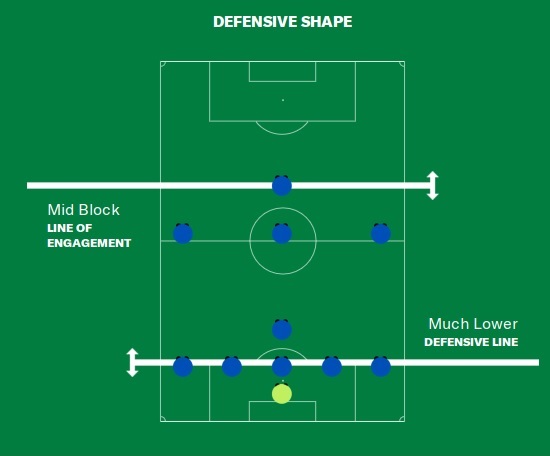
Your team will sit very deep, close to your own goal. This is often used to protect a lead or against very strong attacking teams.
Pros:
- Ideal for protecting a lead by minimizing the space behind the defense.
- Effective against teams with strong attacking capabilities, as it reduces their room to maneuver close to your goal.
Cons:
- Can concede control of the midfield, allowing the opponent to maintain possession and build pressure.
- May lead to a siege mentality, inviting too much pressure on your defense.
2. Lower Defensive Line
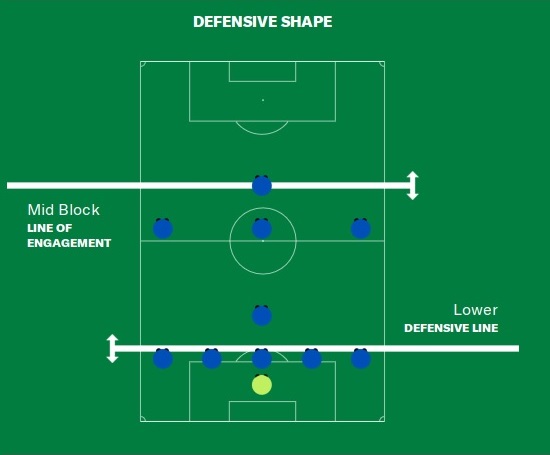
Similar to the much lower defensive line but slightly more advanced. It’s a conservative approach, reducing space behind the defense but potentially allowing space in midfield.
Pros:
- A conservative approach that still offers some midfield presence while reducing vulnerability to fast breaks.
- Useful for teams that lack pace in defense or when facing superior attacking sides.
Cons:
- Risk of allowing opponents space in the midfield, which can be exploited by teams with strong midfield play.
- Can lead to isolation of forwards, making it harder to launch effective counter-attacks.
3. Standard Defensive Line
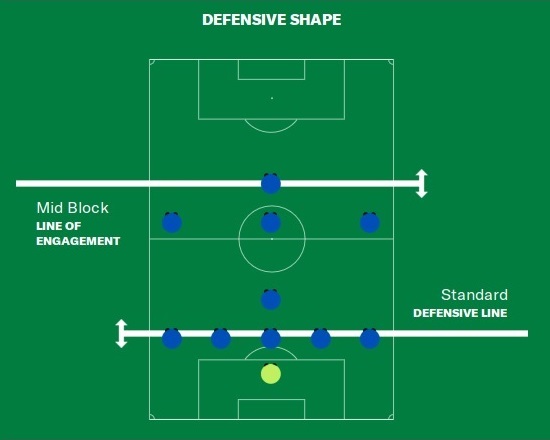
A balanced approach where your team doesn’t sit too deep or push too high. It’s a flexible option that can adapt to different situations.
Pros:
- Offers a balanced defensive approach, suitable for various playstyles and game situations.
- Helps maintain a cohesive unit, keeping the team connected between defense, midfield, and attack.
Cons:
- May not be as effective against teams that are particularly strong in either attacking or defending, as it doesn’t specialize.
- Requires well-rounded players capable of adapting to both defensive and offensive transitions.
4. Higher Defensive Line
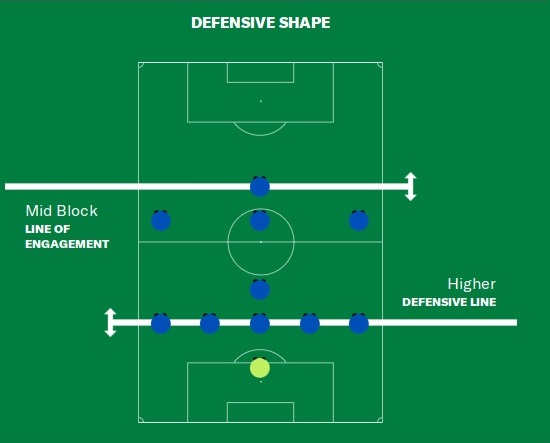
Your team will push up the pitch, reducing the space in midfield but potentially leaving space behind for quick opponents to exploit.
Pros:
- Helps in dominating the midfield and maintaining possession, putting pressure on the opponent.
- Effective for teams with good pressing ability and quick defenders to cover the space behind.
Cons:
- Vulnerable to counter-attacks, especially from teams with fast forwards and skillful long-ball passers.
- Requires high stamina and concentration from defenders to avoid being caught out of position.
5. Much Higher Defensive Line
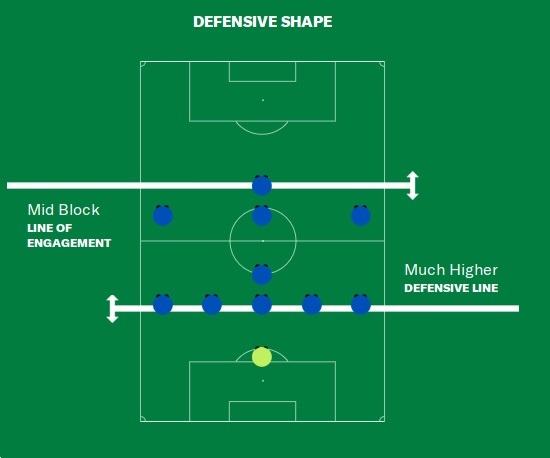
The most aggressive setting, where your team presses high up the pitch. This is risky against teams with fast attackers or good long-ball capabilities.
Pros:
- Maximizes territorial advantage, often overwhelming opponents in their own half.
- Ideal for teams with high pressing tactics and the stamina to sustain such an approach.
Cons:
- Highly risky against teams with fast attackers, as it leaves a lot of space behind the defense.
- Can lead to fatigue and gaps in the defense, especially in the later stages of a match.
Line of Engagement Settings
1. Low Block Line of Engagement
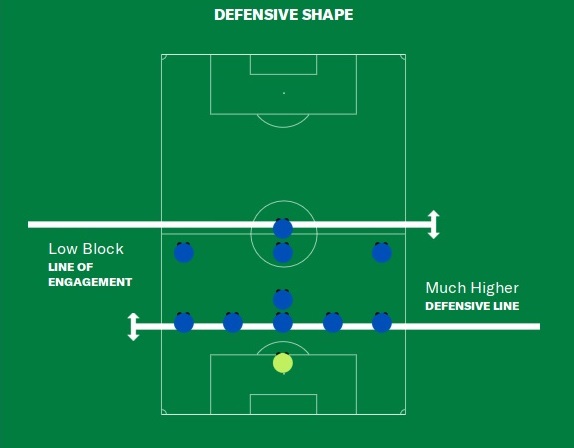
Your team will start pressing the opposition in your own defensive third. This is a passive approach, focusing on maintaining shape and compactness.
Pros:
- Enhances defensive solidity by concentrating players in and around your own defensive third.
- Effective against teams with strong attacking prowess, as it reduces the space they have to exploit.
- Ideal for protecting a lead or for teams with less pace in defense.
Cons:
- Can lead to sustained pressure from the opposition, as your team is less proactive in regaining possession.
- May isolate forwards, making it difficult to transition into attack and relieve pressure on the defense.
- Risks conceding control of the midfield, allowing the opponent to dictate the game.
2. Mid Block Line of Engagement
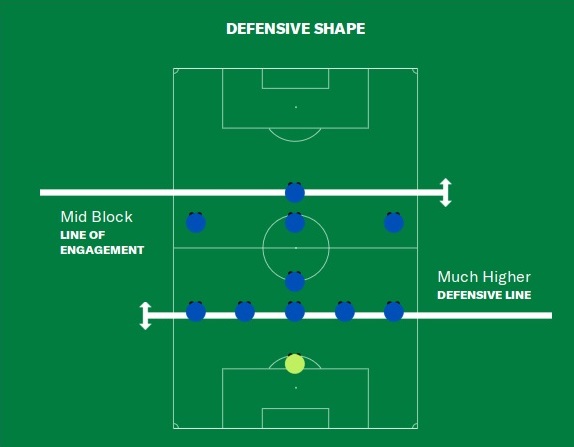
Your team engages the opposition around the midfield area. It’s a balanced approach that doesn’t commit too many players forward or backward.
Pros:
- Offers a balanced defensive approach, engaging the opposition around the midfield area.
- Suitable for various tactical setups, providing flexibility in both attacking and defending.
- Helps in maintaining a compact team shape, reducing gaps between lines.
Cons:
- May not be as effective in exerting high pressure on teams comfortable with possession.
- Requires disciplined midfielders who can effectively transition between defense and attack.
- Can be exploited by teams adept at quick, vertical passing.
3. High Press Line of Engagement
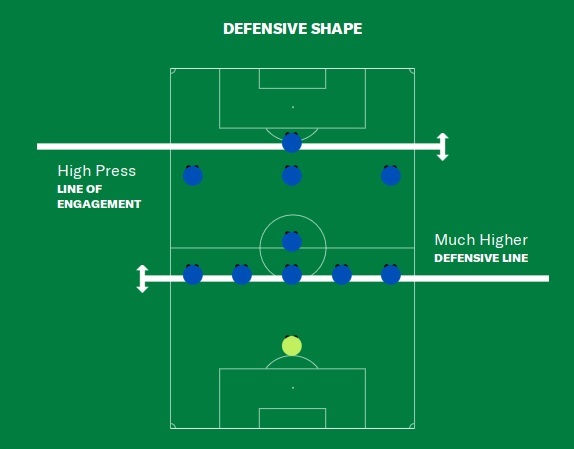
Your team will press the opposition high up the pitch, often in their defensive third. This is an aggressive strategy that aims to win the ball back quickly but can leave you vulnerable to counter-attacks.
Pros:
- Aims to win the ball back quickly by pressing the opposition high up the pitch.
- Ideal for disrupting the opponent’s build-up play and forcing errors.
- Can lead to scoring opportunities through quick transitions after regaining possession.
Cons:
- Leaves space behind the pressing line, which can be exploited by teams with fast attackers or good long-ball capabilities.
- Demands high levels of stamina and discipline from players to maintain the intensity of the press.
- Can be risky against teams with skilled players who can bypass the press, leading to vulnerability on counter-attacks.
Combining Defensive Line Settings with Line of Engagement Settings in Football Manager 2024
The effectiveness of these combinations depends on your team’s strengths, weaknesses, and the style of play you’re aiming for.
Here’s an overview of how different combinations can work:
Much Lower Defensive Line with Low Block Line of Engagement
Pros:
- Maximizes defensive solidity, ideal for protecting leads or facing superior attacking teams.
- Reduces space for opponents to exploit in and around the penalty area.
Cons:
- Can lead to sustained pressure and difficulty in transitioning to attack.
- Risks conceding midfield control, allowing opponents to dictate play.
Lower Defensive Line with Mid Block Line of Engagement
Pros:
- Offers a balanced defensive approach, maintaining some midfield presence while being cautious at the back.
- Useful for countering teams with strong midfield play without being overly defensive.
Cons:
- May struggle against teams that excel in quick transitions or have very fast attackers.
- Requires disciplined players to maintain the balance between defense and midfield.
Standard Defensive Line with Mid Block Line of Engagement
Pros:
- Provides a flexible and adaptable approach, suitable for various playstyles.
- Helps maintain a cohesive unit, keeping the team connected between defense, midfield, and attack.
Cons:
- May not provide enough defensive solidity against very strong teams or enough pressure against weaker teams.
- Requires players to quickly adapt to changing game situations.
Higher Defensive Line with High Press Line of Engagement
Pros:
- Ideal for an aggressive, possession-based style, putting pressure on opponents and dominating the midfield.
- Effective in quickly regaining possession and creating scoring opportunities.
Cons:
- Vulnerable to counter-attacks, especially from teams with fast forwards and skillful long-ball passers.
- Demands high stamina and concentration from players to maintain intensity.
Much Higher Defensive Line with High Press Line of Engagement
Pros:
- Maximizes territorial advantage and can overwhelm opponents in their own half.
- Suits teams with high pressing tactics and players with the stamina to sustain such an approach.
Cons:
- Highly risky against teams with fast attackers, as it leaves a lot of space behind the defense.
- Can lead to fatigue and gaps in the defense, especially in the later stages of a match.
Each combination has its unique tactical implications. Managers should consider their team’s attributes, the opponent’s style, and the context of the match when deciding on the defensive setup.
The key is to find a balance that leverages your team’s strengths while mitigating its weaknesses.
In Conclusion
Each of these settings can be effective depending on the context of the match, the strengths and weaknesses of your team and your opponent, and your overall tactical approach.
It’s important to consider how these settings interact with other tactical instructions, like pressing intensity, team shape, and the roles and duties of individual players.
By understanding and effectively implementing various defensive line settings and line of engagement options, you can significantly enhance your team’s performance.
Remember, a strong defense is not just about preventing goals; it’s about setting the foundation for victory.
FAQs
What is the best defensive line setting for a team with fast defenders?
For teams with fast defenders, a higher defensive line can be effective as it allows the team to play offensively while the defenders’ speed mitigates the risk of being caught on the counter.
How does the line of engagement affect my team’s overall performance?
The line of engagement determines how high up the pitch your team starts pressing the opposition. A higher engagement line can lead to winning the ball back quicker but may tire players out faster and leave space behind for counter-attacks.
Can changing defensive tactics mid-game be effective?
Yes, adapting your defensive tactics based on the match’s flow and your opponent’s strategy can be very effective in countering their strengths and exploiting weaknesses.
What training should I focus on for a low defensive block strategy?
Focus on defensive positioning, teamwork, and stamina training to ensure your players maintain shape, work well together, and endure the physical demands of a low block strategy.
How important are individual player roles in a defensive strategy?
Individual player roles are crucial as they determine each player’s specific actions on the pitch. Ensuring each player’s role aligns with your overall defensive strategy is key to its effectiveness.
Is a high press strategy suitable for every match?
A high press strategy is not suitable for every match. It’s most effective against teams that struggle under pressure but can be risky against teams with skilled players who can bypass the press.
How do I counter a team using a much higher defensive line?
Counter a team with a much higher defensive line by using fast attackers and exploiting the space behind their defense with long balls or quick counter-attacks.
What’s the impact of player morale on defensive performance?
High player morale can significantly boost performance, leading to better positioning, decision-making, and stamina management on the pitch.
Can I use a hybrid of different defensive strategies?
Yes, using a hybrid of different defensive strategies can be effective, allowing you to adapt to various situations in a match.
How do I analyze an opponent’s tactics effectively?
Analyze an opponent’s tactics by reviewing their recent matches, focusing on their formation, key players, and how they react under different types of pressure.
Give us feedback: Was his article helpful?

Comments are closed.